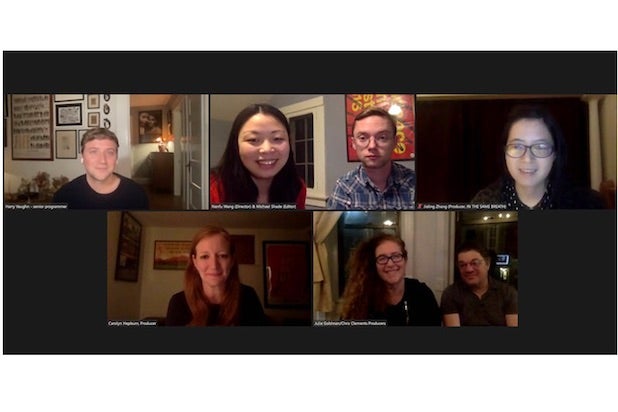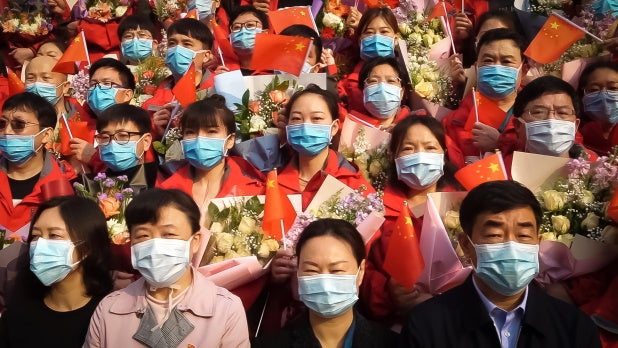

” In the Exact Same Breath” (Courtesy of Sundance Institute).
The COVID-19 pandemic has had a substantial influence on the 2021 Sundance Film Celebration, which was required to take place mostly online, with scattered outside screenings and socially-distanced occasions in cities around the nation. The pandemic has also affected Sundance creatively, leading to an opening four days in which filmmakers have actually utilized a variety of techniques and genres to grapple with the problems of an infection that was simply beginning to surface when the last in-person Sundance took location in Park City a year earlier.
The most obvious example is the opening-night documentary “In the Same Breath” from Chinese-born director Nanfu Wang, who pertained to Park City directly from China in January 2020, and after that found she couldn’t rejoin her other half and son there due to the fact that of the pandemic lockdown. Her film consists of wrenching video footage from Wuhan in the early days of the infection however broadens to look at the Chinese and American governments’ mishandling of the pandemic for political factors.
However a documentary about COVID is far from the only Sundance film to bear the marks of it. Friday, the second day of the celebration, brought an afternoon premiere of Daryl Wein and Zoe Lister-Jones’ funny “How It Ends,” which was shot on the streets of Los Angeles throughout the pandemic and is set on the last day prior to the Earth will be destroyed by an asteroid. Three hours later on, Ben Wheatley premiered “In the Earth,” a horror film that he shot in the U.K. throughout the pandemic, about a society in which an infection has raved unabated for a year.
Also Check Out: Sundance 2021: What Has Sold Up Until Now, From ‘CODA’ to ‘Leave’ (Photos)
Other Sundance films that have absolutely nothing to do with infections have actually somehow caught the state of mind of the minute. As she delved into the story, Walker said when she came into TheWrap’s virtual Sundance studio that she discovered the science denial and political motivations behind the COVID action was likewise present in our action to wildfires.
Meanwhile, Robin Wright’s directorial debut, “Land,” is in some methods a meditation on isolation; the creepy drama “John and the Hole” discovers a family in its own enforced seclusion, which costar Jennifer Ehle compared to pandemic stay-at-home orders; and Christopher Abbott’s performance in Jerrod Carmichael’s “On the Count of Three” is an encapsulation of the rage that lurks under the surface (and often above the surface) in 2021.
Other Sundance movies, even ones set in different times, have wound up speaking to the uncertain and turbulent time in which we live. “When I began, I believed I was making a motion picture about 1969,” director Questlove told TheWrap, referring to his documentary “Summertime of Soul,” which chronicles a Harlem music celebration however expands to cover issues of racial stress. “However then I recognized it was as much about today as it had to do with 50 years ago.”
Also Check Out: ‘ Land’ Movie Review: Robin Wright Relies on Nature for Her Subdued Directorial Launching
Sundance 2021 has definitely had to do with today, starting with the reality that people are watching it from their homes and all the Q&A s are virtual. However it’s likewise about today because the movies handle race (Rebecca Hall’s “Death,” Shaka King’s upcoming “Judas and the Black Messiah”), refugees (the animated documentary “Run away,” the ISIS doc “Sabaya”), phony news (” Misha and the Wolves”), LGBT concerns (” My Call Is Pauli Murray”) and transformations coming from the oddest locations (nuns in “Rebel Hearts,” children’s television in “Street Gang: How We Got to Sesame Street”).
Even the festival’s most significant sale ever, “CODA,” takes a relatively traditional, crowd-pleasing coming-of-age story and provides it a spin that speaks to today’s sobs for inclusion and diversity by casting 3 deaf actors in important functions. And as Sharon Waxman explained, behind the scenes the festival has actually struck brand-new peaks in showcasing work from female directors.
That doesn’t indicate that Sundance ’21 has been everything about current issues; it’s also showcased a common selection of character studies (the docs “Ailey” and “Rita Moreno: Just a Girl Who Chose to Go for It”), difficult dramas (” Mass”) and indie riffs (” R #J,” which tries very tough to update Shakespeare for the social media age).
Likewise Check Out: ‘ Passing’ Movie Review: Rebecca Hall’s Stunning Directorial Debut Provocatively Checks Out Race
Normally, 4 days into a Sundance Movie Festival would be time to look back at the festival so far and look ahead to the staying week– however in this case, nearly whatever has already been showcased. Not only was the festival decreased from its usual 11- day run down to 7 days, however it was likewise severely frontloaded: Of the 74 includes screening over 6 days (the seventh being dedicated to award winners), 67 will have premiered by the end of Sunday.
What’s left are some films that have actually currently played in other places (” Night of the Kings,” “The World to Come”) and Warner Bros.’ best of “Judas and the Black Messiah,” to name a few. Which means that Sundance up until now is basically all the Sundance we’re gon na get– a slimmed-down, virtualized, COVID-ized festival that has set a new record for the greatest deal ever while struggling to capture the Park City sensation when nobody’s in Park City.
The Sundance virtual celebration platform is cutting edge when it comes to moving the festival experience online– however like everything else about the past year, it’s not truly what we desired.
In a pandemic year, we’ll simply have to opt for a pandemic Sundance.
No comments:
Post a Comment